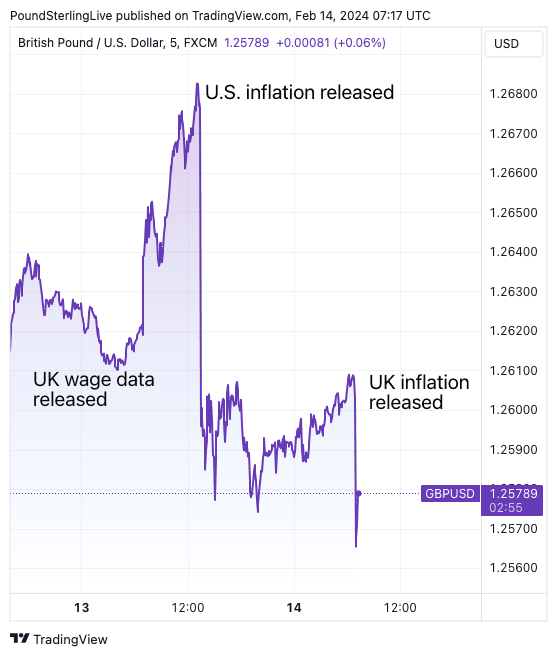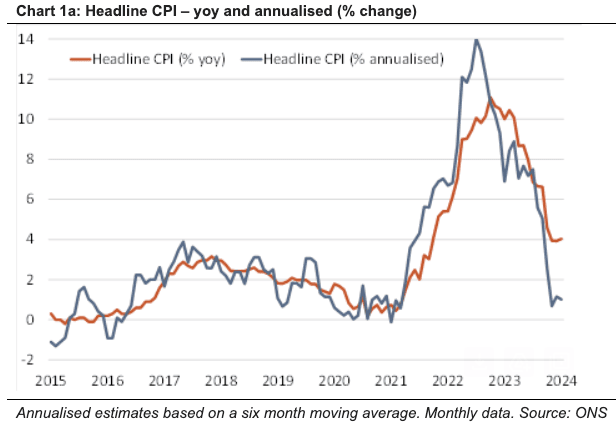Pound Sterling Hit By Inflation Miss
- Written by: Gary Howes

Image © Adobe Stock
Pound Sterling fell against its peers after UK inflation undershot expectations and kept alive hopes that Bank of England interest rate cuts would commence in the summer.
The Pound to Euro exchange rate fell to 1.1730 after it was announced UK headline CPI inflation read at 4.0% year-on-year, unchanged on December, but below the 4.2% figure the market anticipated and the 4.1% the Bank of England forecasted in its February policy update.
This was after the month-on-month change was reported at -0.6%, which was down on December's +0.4% and significantly below the -0.3% the market anticipated.
"UK inflation surprised to the downside this morning, erasing the gains GBP made yesterday following the better-than-expected wage numbers," says Thanim Islam, Head of FX Analysis at Equals Money.
Above: Pound-Dollar at five-minute intervals. Track GBP with your own custom rate alerts. Set Up Here
The Pound to Dollar exchange rate fell to 1.2578 after the all-important core CPI reading was reported at 5.1% y/y, unchanged on December and below expectations for 5.2%.
According to money market pricing (IOS), investors see a roughly 72% chance of a first reduction coming in June, compared with only a 40% chance on Tuesday.
Compare Currency Exchange Rates
Find out how much you could save on your international transfer
Estimated saving compared to high street banks:
£25.00
Free • No obligation • Takes 2 minutes
The Bank of England has said inflation will fall sharply to the 2.0% target as soon as April, largely thanks to the upcoming reduction in energy bills, but will then steadily recover to approximately 3.0% by year-end, underscoring a belief inflation will remain 'sticky' above 2.0%.
This is because core inflationary pressures linked to inflation-beating wage increases will continue to frustrate the Bank's goal of hitting 2.0%. So, although markets are more comfortable betting on Bank of England rate cuts, core inflation could keep expectations in check, offering the Pound support. Altogether, these data for January underscore that core inflation remains elevated and the Bank of England is right to stay vigilant and keep interest rates steady for some time to come.
However, the undershooting against expectations will offer policy-makers some relief in light of Tuesday's strong U.S. inflation print and will maintain market confidence that rates can be cut by the time summer comes around. Had inflation beaten expectations, the prospect of rate cut expectations falling back to Autumn was a real prospect.
The British Pound should ultimately remain supported against European currencies, given softer inflation dynamics emerging in Europe, and these post-release losses should remain contained to recent ranges. However, downside risks against the Dollar are growing as it appears the Bank of England might find itself in a position to cut interest rates ahead of the Federal Reserve.
"The pound has weakened across the board. Sterling had climbed higher against most peers yesterday following the UK jobs report, which showed wage growth slowed by less than forecast, and the unemployment rate unexpectedly dropped to 3.8% versus the 4% expected. However, the softer inflation numbers will likely help pave the way for more rate cuts by the BoE, diminishing the pound’s yield advantage," says George Vessey, Lead FX Strategist at Convera.
Above: In Charts 1a and 1b, Berenberg Bank analysts compare year-on-year and six-month annualised calculations of headline and core inflation. The charts show that while the y/y change remains well above the Bank of England's 2% target for both aggregates, the picture is completely different on a six-month basis. With almost no change in the overall price level between August and January, six-month annualised inflation has hovered around 1% in the previous three prints.
Keeping inflation steady at 4.0% in January was the uptick in gas and electricity prices, as well as strong services inflation, which rose from 6.4% to 6.5%.
The Bank of England is particularly concerned about the persistence of services inflation linked to high wages and will want to see further progress lower in this component before cutting interest rates.
But Samuel Tombs, Chief UK Economist at Pantheon Macroeconomics, calculates that the three-month-on-three-month annualised growth in the Bank of England's preferred services CPI slowed to 3.7%, which would be the lowest rate since February 2022, down from 4.7% in December.
Image: Courtesy of Pantheon Macroeconomics.
Kallum Pickering, an economist at Berenberg Bank says short of another major supply shock to prices, y/y rates of headline and core inflation look set to fall rapidly further over coming months as base effects fully wash out.
"We expect headline y/y inflation fall to 2% in spring and to slightly below 2% through Q3. Today’s inflation print keeps the BoE on track for five cuts in 2024 starting in June," says Pickering.
Foreign exchange markets will next turn focus to the UK's GDP numbers for January and the final quarter of 2023, where a contraction is expected to confirm the economy slipped into recession in the second half of the year.
Should the data undershoot expectations, we could see a further washout of Pound Sterling's strong 2024 performance.
"Tomorrow’s GDP data is widely anticipated to reveal the UK fell into a recession at the end of last year. Though Andrew Bailey has pushed back with an expectation that it will be both shallow and short lived, pressure on the Bank to cut rates sooner rather than later will no doubt continue, and today’s CPI data release will do very little to change that," says Lindsay James, investment strategist at Quilter Investors.
Compare Currency Exchange Rates
Find out how much you could save on your international transfer
Estimated saving compared to high street banks:
£25.00
Free • No obligation • Takes 2 minutes








